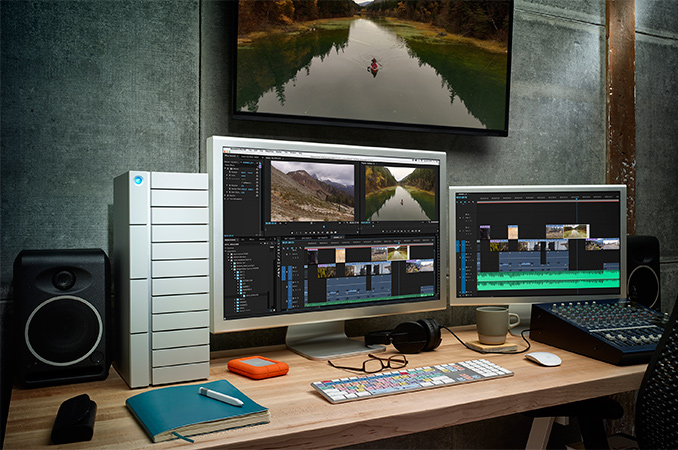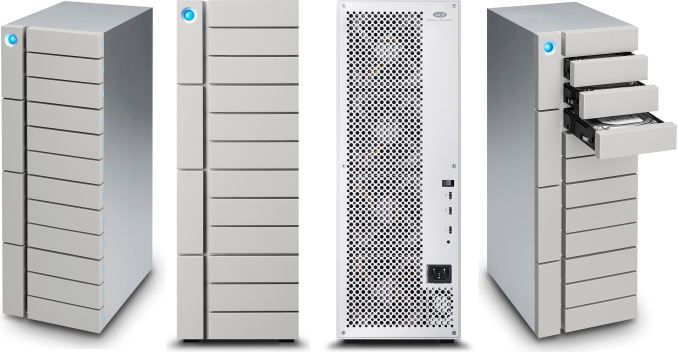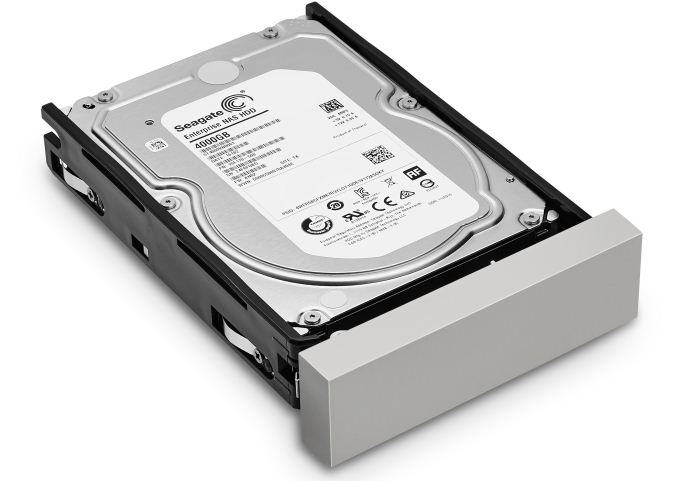LaCie Launches 6big and 12big: Up to 60/120 TB External Storage with Thunderbolt 3
by Anton Shilov on November 1, 2016 9:30 AM EST
LaCie this week has introduced two new workstation-grade external storage solutions using Thunderbolt 3 with the focus on big on-the-desk data storage. The 6big and 12big devices pack in six or twelve enterprise-grade hard drives respectively and can provide up to 60 TB or up to 120 TB of storage space. The HDDs can be implemented as a JBOD or work in various RAID modes. LaCie’s devices promise to be able to take advantage of Thunderbolt 3’s 40 Gb/s bandwidth by providing up to 1400 MB/s or 2600 MB/s read speeds, which can be important for those who work with UHD video content.
The LaCie 6big and 12big DAS with six and 12 drive bays are made of aluminum and come with integrated PSUs and cooling. The storage devices are based on a proprietary platform from LaCie, which supports hardware RAID 0/1/5/6/10/50 modes. Seagate, the owner of the LaCie brand, does not disclose details about the platform behind the new DAS products, but it naturally has a hardware RAID controller (presumably from Seagate’s LSI division) as well as Intel’s Alpine Ridge controller for Thunderbolt 3.
The LaCie 6big and the LaCie 12big external storage devices will be sold in various configurations that use different hard drives, all of which support hot swapping and feature 7200 RPM spindle speed. The top-of-the-range 60 TB and 120 TB models use Seagate’s helium-filled Enterprise Capacity 10 TB HDDs rated for 2 million MTBF and 550 TB/year writes unannounced 10 TB HDD. Meanwhile the lower-capacity DAS devices will use Seagate’s Enterprise NAS HDDs rated for 1.2 million hours MTBF and 300 TB/year writes. The LaCie 6big and 12big will initially be available fully populated, and from a performance point of view maximum read and write speeds will mostly depend on RAID modes.
Update 11/3: As it appears, the LaCie 6big and 12big DAS do not use Seagate's Enterprise Capacity 10 TB HDDs, but rely on unannounced 10 TB drives from the company.
| The LaCie 6big and 12big DAS | |||||
| 6big | 12big | ||||
| HDDs | Unannounced 10 TB HDD Enterprise NAS 8 TB Enterprise NAS 6 TB Enterprise NAS 4 TB |
||||
| Maximum Number of HDDs | 6 | 12 | |||
| Capacity | 60 TB (6 × 10 TB) 48 TB (6 × 8 TB) 36 TB (6 × 6 TB) 24 TB (6 × 4 TB) |
120 TB (12 × 10 TB) 96 TB (12 × 8 TB) 72 TB (12 × 6 TB) 48 TB (12 × 4 TB) |
|||
| RAID | 0/1/5/6/10/50 | ||||
| RAID 0 | Read Speed | 1400 MB/s | 2600 MB/s | ||
| Write Speed | 1400 MB/s | 1700 MB/s | |||
| RAID 5 | Read Speed | 1200 MB/s | 2400 MB/s | ||
| Write Speed | 1150 MB/s | 1200 MB/s | |||
| Ports | 2 × Thunderbolt 3 1 × USB Type-C |
||||
| Fans | 2 | 4 | |||
| PSU | 250 W | 400 W | |||
| Dimensions (W x H x L) | 161 × 225 × 237 mm 6.3 × 8.9 × 9.3 inch |
161 × 447 × 237 mm 6.3 × 17.6 × 9.3 inch |
|||
| Cables Included | USB-C (Thunderbolt 40Gb/s or USB 3.1 10Gb/s) cable USB-C to USB-A cable Power cable |
||||
| Software | LaCie RAID Manager LaCie Private-Public for AES 256-bit software encryption Intego Backup Manager Pro Genie Backup Manager Pro |
||||
| Prices | 24 TB starts at $3199 | 48 TB starts at $6399 | |||
Both DAS solutions from LaCie feature two Thunderbolt 3 ports, making it possible to daisy-chain a display or another TB3 device to the storage arrays. In addition, the 6big and the 12big are equipped with one USB 3.1 Type-C connector which allows to use them with systems not equipped with TB3, but at considerably lower speeds (i.e., up to 350 – 400 MB/s depending on RAID mode).
Like other LaCie’s DAS products with multiple drives, the 6big and the 12big come with the company’s proprietary RAID management software that allows setting them up and then monitoring the condition of the drives.
For pricing the LaCie 6big 24 TB starts at $3199 whereas the LaCie 12big 48 TB starts at $6399.
Source: LaCie
























41 Comments
View All Comments
fred666 - Tuesday, November 1, 2016 - link
It's probably a better idea to get a PC with many SATA ports and hard drive bays instead of this.bill.rookard - Tuesday, November 1, 2016 - link
Yup. Even if you went high end with a Xeon 2U 8bay, you'd be looking at far less than this for roughly equivalent storage. Yes, this is more plug and play, but anyone into the kind of video editing that would require this type of storage would have an IT guy who could set it up and manage it.Guspaz - Tuesday, November 1, 2016 - link
I'm not sure if this is still the case today, but i3 chips were a popular choice for NAS servers a few years ago due to their support of ECC RAM (which for some reason i5/i7 chips don't).Samus - Tuesday, November 1, 2016 - link
Well, definitely more cost effective and secure than a fancy aluminum tower sitting on your desk. That's for sure. If performance isn't a key metric to consider, even a Drobo or two would save a ton of money, but obviously this is a performance product.lorribot - Tuesday, November 1, 2016 - link
Anyone not using at least raid 6 with these is risking their work. SAT is good at hiding disk faults which you only find when you try a rebuild of an array.Also what would back this up to? This sort of capacity is better being served over the network (from a locked secure room) rather than locally, this only makes sense to people with too much money and no idea about data protection.
Guspaz - Tuesday, November 1, 2016 - link
Network storage isn't always a good match for film editing, where video bitrates can get into the multiple gigabits per second. Raw 8K60 isn't going to happen on anything short of a 10GigE network, and that can get very expensive very fast.A more sensible option may be fast local storage (something like LaCie's option here) combined with a big cheap slow backup server in the network closet with footage being backed up over regular GigE.
faiakes - Tuesday, November 1, 2016 - link
WTF!?!What on earth justifies that price?
Why the f $@^ is a 250w PSU needed to run 6 drives, 2 fans and the logic?
Fu@#$^% as swipes...
ZeDestructor - Tuesday, November 1, 2016 - link
Startup current is why. The average modern drive pulls roughly 2A on 12V startup + the .5A on 5V for the controller. 6 drives = ~160W for just the drives. Add in 5W per fan and 20W for the board/controller and you've hit about 200W. Then to top it off, you engineer in a little bit of headroom and/or pick up the closest off the shelf PSU and congratulations: 250W's your ideal choice of PSU.PS: add in another 160W for the 12disk version and you hit 410W, so you go for the nearby 400W PSU rather than the more expensive 450W one.
faiakes - Thursday, November 3, 2016 - link
Alright...Didn't account for startup power demands.
Still...over 3000 for a measly PSU and metal frame...even with the logic...
andychow - Monday, November 7, 2016 - link
Private-Public for AES? Isn't AES symmetric? They mean RSA? I'm confused.